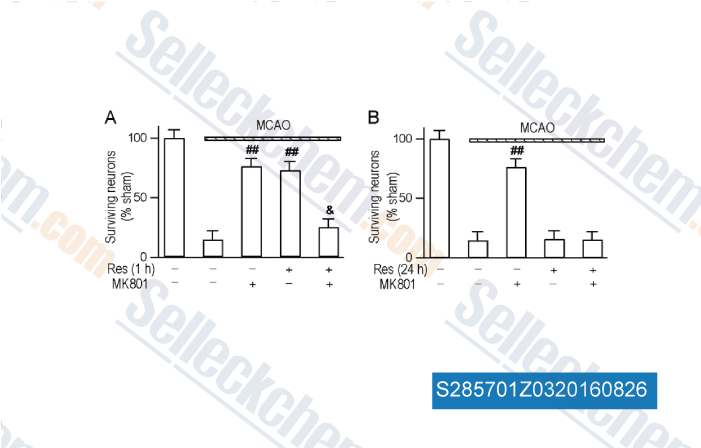|
Toll Free: (877) 796-6397 -- USA and Canada only -- |
Fax: +1-832-582-8590 Orders: +1-832-582-8158 |
Tech Support: +1-832-582-8158 Ext:3 Please provide your Order Number in the email. |
Technical Data
| Formula | C16H15N.C4H4O4 |
|||
| Molecular Weight | 337.37 | CAS No. | 121917-57-5 | |
| Solubility (25°C)* | In vitro | DMSO | 67 mg/mL (198.59 mM) | |
| Ethanol | 67 mg/mL (198.59 mM) | |||
| Water | Insoluble | |||
|
* <1 mg/ml means slightly soluble or insoluble. * Please note that Selleck tests the solubility of all compounds in-house, and the actual solubility may differ slightly from published values. This is normal and is due to slight batch-to-batch variations. * Room temperature shipping (Stability testing shows this product can be shipped without any cooling measures.) |
||||
Preparing Stock Solutions
Biological Activity
| Description | (-)-Dizocilpine (MK 801, Dizocilpine, C13737) Maleate is a potent N-methyl-D-aspartate (NMDA) receptor antagonist with Ki of 30.5 nM. | ||
|---|---|---|---|
| Targets |
|
||
| In vitro | Neurophysiological studies in vitro, using a rat cortical-slice preparation, demonstrates a potent, selective, and noncompetitive antagonistic action of dizocilpine on depolarizing responses to N-Me-D-Asp but not to kainate or quisqualate. The potencies of phencyclidine, ketamine, SKF 10047, and the enantiomers of dizocilpine as N-Me-D-Asp antagonists correlate closely (r = 0.99) with their potencies as inhibitors of [3H] dizocilpine binding. This suggests that the dizocilpine binding sites are associated with N-Me-D-Asp receptors and provides an explanation for the mechanism of action of dizocilpine as an anticonvulsant. [1] | ||
| In vivo | All the control rats have severe permanent neurological deficits after ischemic spinal cord injury (ISCI), whereas the dizocilpine–treated rats have statistically (P < .05) better neurological outcome and good recovery. Histopathology reveals severe neuronal necrosis in the lumbar gray matter of control rats, whereas dizocilpine–treated rats show mild injury. These results demonstrate that a single dose of dizocilpine given before ISCI provides significant neuroprotection. [3] |
Protocol (from reference)
| Kinase Assay:[1] |
|
|---|---|
| Cell Assay:[2] |
|
| Animal Study:[3] |
|
References
Customer Product Validation

-
Data from [Data independently produced by , , Pharmacology, Biochemistry and Behavior, 2016, 146-147:21–27.]
Selleck's (-)-Dizocilpine (MK 801) Maleate has been cited by 10 publications
| Sevoflurane upregulates neuron death process-related Ddit4 expression by NMDAR in the hippocampus [ Aging -Albany NY), 2023, 15(12):5698-5712] | PubMed: 37348034 |
| Sevoflurane upregulates neuron death process-related Ddit4 expression by NMDAR in the hippocampus [ Aging (Albany NY), 2023, 15(12):5698-5712] | PubMed: 37348034 |
| Characterization of Non-Specific Uptake and Retention Mechanisms of [177Lu]Lu-PSMA-617 in the Salivary Glands [ Pharmaceuticals (Basel), 2023, 16(5)692] | PubMed: 37242475 |
| Functionally distinct roles for eEF2K in the control of ribosome availability and p-body abundance [ Nat Commun, 2021, 12(1):6789] | PubMed: 34815424 |
| Lipid bilayers regulate allosteric signal of NMDA receptor GluN1 C-terminal domain [ Biochem Biophys Res Commun, 2021, 585:15-21] | PubMed: 34781056 |
| Ketamine inhibits aerobic glycolysis in colorectal cancer cells by blocking the NMDA receptor-CaMK II-c-Myc pathway. [ Clin Exp Pharmacol Physiol, 2020, 47(5):848-856] | PubMed: 31889340 |
| Propofol Disrupts Aerobic Glycolysis in Colorectal Cancer Cells via Inactivation of the NMDAR-CAMKII-ERK Pathway [ Cell Physiol Biochem, 2018, 46(2):492-504] | PubMed: 29614493 |
| Local Administration of Thiamine Ameliorates Ongoing Pain in a Rat Model of Second-Degree Burn [Zhang K J Burn Care Res, 2017, 38(5):e842-e850] | PubMed: 28181986 |
| Shift in interictal relative gamma power as a novel biomarker for drug response in two mouse models of absence epilepsy [Maheshwari A Epilepsia, 2016, 57(1):79-88] | PubMed: 26663261 |
| Resveratrol protects CA1 neurons against focal cerebral ischemic reperfusion-induced damage via the ERK-CREB signaling pathway in rats [Li Z, et al. Pharmacol Biochem Behav, 2016, 146-147:21-27] | PubMed: 27143440 |
RETURN POLICY
Selleck Chemical’s Unconditional Return Policy ensures a smooth online shopping experience for our customers. If you are in any way unsatisfied with your purchase, you may return any item(s) within 7 days of receiving it. In the event of product quality issues, either protocol related or product related problems, you may return any item(s) within 365 days from the original purchase date. Please follow the instructions below when returning products.
SHIPPING AND STORAGE
Selleck products are transported at room temperature. If you receive the product at room temperature, please rest assured, the Selleck Quality Inspection Department has conducted experiments to verify that the normal temperature placement of one month will not affect the biological activity of powder products. After collecting, please store the product according to the requirements described in the datasheet. Most Selleck products are stable under the recommended conditions.
NOT FOR HUMAN, VETERINARY DIAGNOSTIC OR THERAPEUTIC USE.
